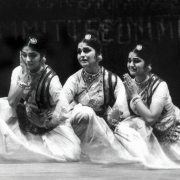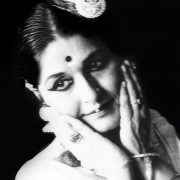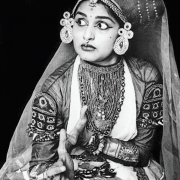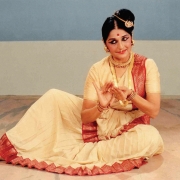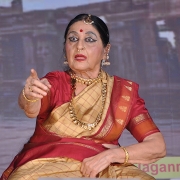
People
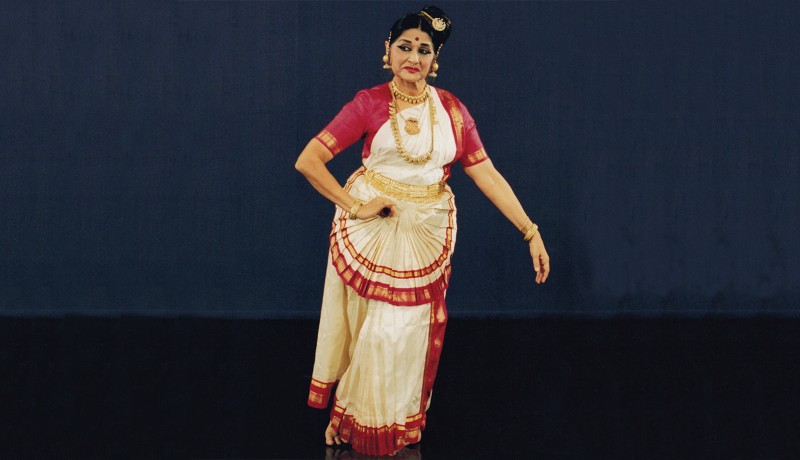
Through her incredible work of a lifetime, legendary Mohiniattam exponent Padma Bhushan Dr Kanak Rele has breathed fresh air into the dance form and given it a place of its own in the realms of Indian classical dance. In conversation with Sai Prabha Kamath, the doyenne shares her journey of resurrecting Mohiniattam from the throes of extinction
In the quiet neighbourhood of JVPD Scheme in the western suburbs of Mumbai, the Nalanda Dance Research Centre is not just a landmark; it is a monument to the performing arts. As we enter the three-storeyed building, we are welcomed by the reverberations of thattu kizhi (an instrument comprising a wooden plank and a stick to provide rhythmic beats to dance) and thumping feet. This institution has created generations of distinguished performers, academicians and teachers in fine arts. And, for Dr Kanak Rele, the 80 year-old founder-director of Nalanda and rejuvenator of Mohiniattam, “establishing the institution has allowed me to take dance to everyone, which was and is my ultimate goal.” As we settle down for an interview in her spacious administrative office amid intermittent school bells and phone enquiries, Dr Rele—graceful in a red sari and plaited hair—shares how her life is irrevocably intertwined with the journey of Nalanda and how resurrecting Mohiniattam became her mission.
THE JOURNEY BEGINS
She was born in a Gujarati aristocratic family from Bombay who were staunch nationalists and Gandhians. “We used to wear only khadi and as a young girl, I used to spin the charkha,” she reminisces. When her father passed away at a very young age, she and her mother shifted for a short time to Santiniketan in West Bengal, where her uncle was learning painting. “There, I vaguely remember seeing an old man with a long beard wearing a peculiar gown—that must have been Rabindranath Tagore!” she recalls. The creative atmosphere left an indelible mark on the young mind. “My mom used to tell me that whenever I saw a dance, I used to be transfixed and used to watch the dancers intently.”
After returning from Santiniketan, she was initiated into Kathakali when she was six, under the late guru ‘Panchali’ Karunakara Panikkar. “My guru was a giant in facial expressions and streevesham [female character] in Kathakali. I was one of the first women to learn Kathakali and I continued learning from him.” Later, Dr Rele also went on to learn Bharatanatyam under legendary gurus Nana Kasar and Chokkalingam Pillai but never had the inclination to pursue the dance form.
THE LAWYER-DANCER
After her marriage to Yatin Rele, a well-known cricketer and banker, she shifted to the UK and went on to study international law in civil aviation at the University of Manchester. However, she continued practising dance. “Upon our return to Bombay, I was offered a job in Air India. At this juncture, I declared I wanted to be a professional mainstream dancer and not pursue a career in law. My mother was really upset with me as there was a social stigma attached to taking up dancing as a career. However, I continued unabated with the wholehearted support of my husband.”
ESTABLISHING NALANDA
In the 1960s, students generally had to spend huge amounts to have an arangetram (dance initiation on stage) under established gurus. “I was shocked to learn this from dance students from humble backgrounds.” Her belief that dance should be for all prompted her to establish Nalanda, a centre for imparting dance training without any discrimination. “When we were allotted this piece of land by the government, it used to get flooded frequently owing to its proximity to Juhu beach,” she recalls. Despite many such odds, Nalanda was born in 1967. Her husband was a pillar of support as they built the centre brick by brick. “If I handled the professional part, Yatin, with his banking background, handled the finances superbly.”
To give dance an academic temper, the visionary in Dr Rele next came up with a proposal to have a degree for dance, something unheard of in those times. Though she received a lot of criticism for the idea, she was successful in obtaining a University Grants Commission (UGC) scale for dance. Indeed, she worked hard on formulating a structure for the course. In 1973, Dr Rele opened Nalanda Nritya Kala Mahavidyalaya, an exclusive college for dance affiliated to the University of Mumbai, empowering students who were artistically inclined to take up arts as a full-time career option.
THE REVIVALIST
Simultaneously, Dr Rele continued giving Kathakali performances all around the world. But destiny had something else in store. Her true calling came when she met Kalamandalam Rajalakshmi, a Mohiniattam teacher, and started learning the dance form from her. “Mohini is the enchantress and attam means dance. It is a dance form with lyrical feminism, gentle movements and distinct facial expressions. I had seen Mohiniattam before and used to love the white-and-gold costumes and traditional hairdo. And when I started training in it, I entered a fantastic world of beauty from which I have never returned.”
Owing to lack of patronage, Mohiniattam—a classical dance form from Kerala that traces its technique to Natya Shastra, the ancient Sanskrit text on performance arts—had become a dying art on the brink of extinction. When Dr Rele learnt about this, she took it upon herself to revive this dance form; for this, she made several trips to Kerala with her husband. In 1970-71, a research grant enabled her to document the dance through its surviving exponents, Kunjukuttyamma, Chinammuamma and Kalyanikuttyamma. With this recorded data, she structured the dance form and created a new grammar, methodology and technique, thus rejuvenating it. “Mohiniattam is my life now,” she shares.
ENRICHING MOHINIATTAM
Dr Rele’s untiring efforts to revive Mohiniattam caught the eyes of Kerala’s poet-dramatist-scholar Kavalam Narayana Panikkar. Watching her dance to Carnatic music, he suggested she change the rendition to Sopana Sangeetham, a blend of Vedic, folk and tribal music of Kerala. As Sopana Sangeetham was the base for Kathakali too, Dr Rele lapped up the idea. They worked in collaboration for over three decades, with Dr Rele choreographing to Panikkar’s lyrics, until his death in 2016.
Dr Rele’s endeavour to enrich Mohiniattam and put it on a pedestal made her explore powerful subjects, including social concerns. “According to the tenets of the Natya Shastra, dancers are not qualified to take sides or present current issues. So in my dance presentations such as A-Neeti and The Enlightened One – Gautama Buddha, I portray characters from Indian mythology and Hindu epics with current nuances,” she explains. Through her productions such as Kubja, Draupadi and Gandhari, she has touched upon several contemporary social issues of women too.
ACCOMPLISHMENTS GALORE
Apart from Mohiniattam, Dr Rele has choreographed a vast repertoire of classical dance-dramas such as Amrut Manthan, Dashavatara and Shodashopachara. A regular performer at programmes in India and abroad, she recently enthralled the audience at the cultural festival Kalabhivardhana 2018 in Mysuru, where she was also conferred the ‘Natya Kalottunga’ award.
As a dance pedagogist, Dr Rele is the only dance exponent on the Curriculum Development Committee of UGC and has been invited by several educational institutions to formulate their courses of study. And her internationally registered research on body kinetics for Mohiniattam is accepted all over the world today. Further, she has made documentaries on dancing legends such as Birju Maharaj, Kelucharan Mohapatra and Ramankutty Nair. Her documentary Nritya Bharati, on the seven Indian classical dance forms (Bharatanatyam, Kuchipudi, Odissi, Mohiniattam, Kathakali, Kathak and Manipuri), has been acquired by the Ministry of External Affairs as the official capsule for dance missions overseas.
What’s more, several prestigious universities and learning institutions for Indian performing arts have prescribed Dr Rele’s Mohiniattam – The Lyrical Dance and Bhaavanirupana as textbooks for their undergraduate and postgraduate courses. Indeed, in 2013, for her remarkable work in Mohiniattam, Dr Rele was honoured with the Padma Bhushan; the same year, she received a fellowship from the Sangeet Natak Akademi, the Akademi Ratna.
PRESENT PERFECT
Life has come full circle for Dr Rele as the Sangeet Natak Akademi is soon releasing a documentary on the life of the doyenne. “Right now, I am busy giving them my inputs.” Does she feel dance is evolving? “Yes,” she replies. “In fact, dancers have started experimenting more now with different themes. For my production Gandhari some years ago, I danced with my eyes closed, which was seen as an innovation then. In my opinion, the content can change but the form should not.”
Her current projects include choreographing Jayadeva’s Ashtapadi along with her senior students, formulating a master’s course in movement science, and archiving works of her lifetime for Nalanda.
A LIVING LEGACY
Today, while Dr Rele oversees the administration of Nalanda, her family is also involved in the institution’s myriad activities: her daughter-in-law Uma, who holds a doctorate degree from Nalanda, is the principal of Nalanda Nritya Kala Mahavidyala, and son Rahul, a businessman, helps run the institution. The love for dance truly runs in the family. “My granddaughter Vaidehi, who is a solicitor like me, has now registered for a PhD with the institution.”
In its 51st year, the institution has certainly come a long way. “Today, it is the premier dance institution in the country recognised as a scientific and industrial research organisation by the Ministry of Science and Technology, and offers bachelor of fine arts (dance), master of fine arts (dance) and PhD in dance, apart from various diplomas,” says Dr Rele with pride. “I will be leaving behind dance and movement in every corner of this institute.”
AWARDS AND HONOURS
- Nrityachoodamani, Madras (1978)
- Gaurav Puraskar from Gujarat government (1989)
- Padma Shri (1990)
- Sangeet Natak Akademi Award (1994)
- Kala Vipanchee (2004)
- Kalidas Samman (2005-06)
- Padma Bhushan (2013)
- Sangeet Natak Akademi Fellowship, Akademi Ratna (2013)
- Natya Kalottunga (2018)
A FLAG-BEARER OF ACTIVE AGEINGAt 80, Dr Rele leads an active life despite a major foot surgery a couple of years ago. While her day is dedicated to the administrative work of Nalanda, her evenings are reserved for project preparations and seminar presentations. “After a brief illness, my husband is recuperating at home; I have started spending more time with him now,” she shares. A voracious reader, her day is incomplete without practising dance, yoga, pranayama and Pilates. “In fact, dance is the highest form of yoga,” she declares. She is a small eater. “I am happy with just khakra and chaas. But for a healthy life, what matters is what you eat and how you treat your body. Do not neglect it,” she advises. Emphasising that age should not deter one from living life to the fullest, she adds, “I have friends who have isolated themselves because of their age. Share your knowledge or care for your grandchildren—silvers need to come forward and be a part of society.” |
|---|
Photos courtesy: Dr Kanak Rele Featured in Harmony — Celebrate Age Magazine May 2018
you may also like to read
-
For the love of Sanskrit
During her 60s, if you had told Sushila A that she would be securing a doctorate in Sanskrit in the….
-
Style sensation
Meet Instagram star Moon Lin Cocking a snook at ageism, this nonagenarian Taiwanese woman is slaying street fashion like….
-
Beauty and her beast
Meet Instagram star Linda Rodin Most beauty and style influencers on Instagram hope to launch their beauty line someday…..
-
Cooking up a storm!
Meet Instagram star Shanthi Ramachandran In today’s web-fuelled world, you can now get recipes for your favourite dishes at….



